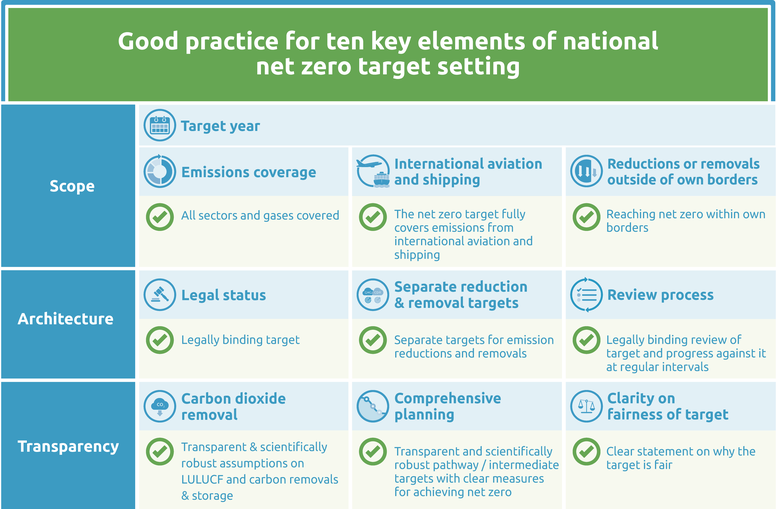Net zero targets
Summary
We evaluate the net zero target as: Average
Just before COP26, Thailand committed to a ‘carbon neutrality’ target for 2065 in its Long-term Low Greenhouse Gas Emission Development Strategy (LTS) submitted to the UNFCCC in October 2021 (Thailand Government, 2021).
During the conference, Prime Minister Prayut suggested the country will move the ‘carbon neutrality’ target forward to 2050 and commit to ‘net zero’ emissions by 2065 (Bangkok Tribune, 2021). Neither target has been included in any policy document or law as of August 2022. For this reason, we assess Thailand’s existing ‘carbon neutrality’ target for 2065 as part of its officially submitted LTS, recognising that there remains ambiguity about the ultimate position of the Government.
Thailand’s ‘carbon neutrality’ target in its LTS covers all sectors and many of the key elements constituting a transparent and comprehensive target. Thailand’s strategic goals to reduce emissions towards mid-century and beyond depend heavily on LULUCF sinks and large-scale carbon capture and storage (CCS) technologies for the energy sector.
Thailand could further improve its carbon neutrality target informed by key elements considered important by the CAT to enhance transparency, target architecture, and scope. For example, the Thai government currently neither provides information on whether its 2065 target covers international aviation and shipping nor explains why it considers the target a fair contribution to the global goal of limiting warming to 1.5˚C above pre-industrial levels. The government has also announced a review circle of five-year intervals, but it remains unclear whether this is legally binding.
Ten key elements
Scope
- Target year – Thailand aims to reach ‘carbon neutrality’ by 2065.
- Emissions coverage – The terminology of a ‘carbon neutrality’ target might be misleading as the LTS analyses most GHG emissions and not just exclusively CO2 emissions. The GHG gases covered in the existing LTS jointly account for over 99% of Thailand’s GHG emissions in 2021 according to the latest available PRIMAP historical data (Gütschow, Günther and Pflüger, 2021). The target covers all sectors of the economy including energy, industry, agriculture, agriculture and land use, and waste.
- International aviation and shipping – Thailand provides no information on its intention to cover international aviation and shipping.
- Reductions or removals outside of own borders – The LTS covers different national strategies to reduce or remove GHG emissions domestically. It does not mention any reductions or removals outside of Thailand’s borders.
Target architecture
- Legal status – Thailand included its ‘carbon neutrality’ target for 2065 in its Mid-century, Long-term Low Greenhouse Gas Emission Development Strategy, which the Thai government submitted to the UNFCCC in October 2021 (Thailand Government, 2021). At COP26, Prime Minister Prayut announced to move the ‘carbon neutrality’ target forward to 2050 and committed to ‘net zero’ emissions by 2065 (Bangkok Tribune, 2021). Neither target has been included in any policy document or law as of August 2022.
- Separate reduction & removal targets – Thailand communicates separate emission reduction and removal targets. It expects to reach a level LULUCF removals of 120 MtCO2e by 2037, staying at the same amount until 2050. Due to energy improvements (efficiency increase of 43% by 2050), CCS and a higher share of renewable electricity (33% of total electricity generation by 2050), emissions are estimated to decrease significantly after 2040.
- Review process – Thailand is in the process of establishing a review cycle every 5 years for its long-term strategy (Thailand Government, 2021).
Transparency
- Carbon dioxide removal – Thailand provides transparent pathways and targets for LULUCF and separately for removals and storage as part of its LTS submitted to the UNFCCC (Thailand Government, 2021). The Thai government aims to achieve LULUCF sinks of approximately 120 MtCO2e annually by 2037 and assumes these sinks to remain stable through the end of this century. The Thai government provides no assumptions on other carbon dioxide removal and storage.
- Comprehensive planning – In its LTS, Thailand shows a pathway for economy-wide emissions levels, sectoral emissions levels and LULUCF until 2100, and discusses sectoral emission projections for 2050 (Thailand Government, 2021). The Thai government plans to achieve emissions reductions in the energy sector through both a higher renewable electricity share and the use of CCS technologies, the latter of which aims at continuing the use of fossil gas and coal power plants beyond mid-century. Thailand estimates to annually capture 18 MtCO2e by 2050 under their pathway to achieve net zero emissions by 2065. Main mitigation measures in other sectors are the modification of industrial production processes, community projects and agricultural measures like manure management. For different sectors, Thailand provides intermediate targets for 2030 and 2050.
- Clarity on fairness of target – Thailand makes no reference to fairness or equity in the context of its net zero target.
Good practice
The Climate Action Tracker has defined the following good practice for all ten key elements of net zero targets. Countries can refer to this good practice to design or enhance their net zero targets.
Further analysis
Latest publications
Stay informed
Subscribe to our newsletter







